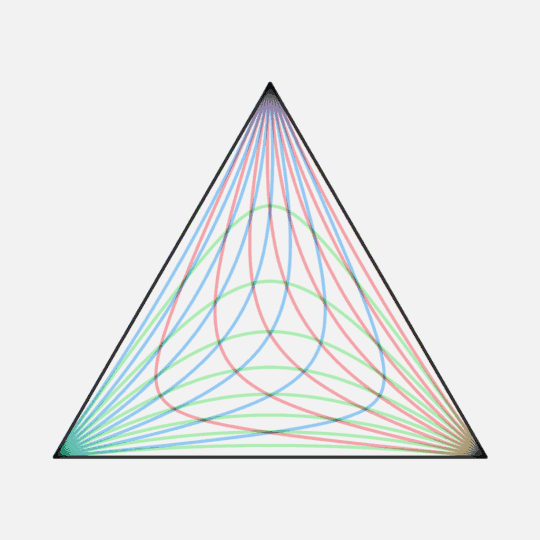
Isogonal
Take the isogonal conjugates of lines parallel to a triangle's edges, then let the lines translate parallel to themselves; the result is the above animation. Here's the code:
SideVectors[?_] := (#[[2]] - #[[1]]) & /@
Transpose[{?[[1]], RotateLeft[?[[1]]]}];
SideLengths[?_] := Norm /@ SideVectors[?];
BarycentricCoords[?_, t_] :=
Sum[t[[i]] ?[[1, i]], {i, 1, 3}]/Total[t];
TrilinearCoords[?_, {?_, ?_, ?_}] :=
Module[{a, b, c},
{a, b, c} = SideLengths[?];
BarycentricCoords[?, {? a, ? b, \
? c}]
];
EquilateralTriangle = Triangle[{{0, 0}, {1, 0}, {1/2, Sqrt[3]/2}}];
isogonal =
With[{cols =
RGBColor /@ {"#FF5964", "#6BF178", "#35A7FF", "#333333"},
n = 9},
ParallelTable[ImageMultiply @@
Append[
Flatten[
Table[
ParametricPlot[
TrilinearCoords[EquilateralTriangle,
RotateLeft[
1/{i + s/n, (1 - i - s/n) t, (1 - i - s/n) (1 - t)},
j]],
{t, .00001, .99999},
PlotStyle ->
Directive[CapForm[None], Thickness[.006], Opacity[.5],
cols[[j + 1]]], ImageSize -> 1080, Background -> White,
Axes -> False,
PlotRange -> {{-1/8, 9/8}, {Sqrt[3]/4 - 5/8,
Sqrt[3]/4 + 5/8}}],
{j, 0, 2}, {i, 0., 1 - 1/n, 1/n}]],
Graphics[{FaceForm[None],
EdgeForm[
Directive[JoinForm["Round"], Thickness[.006], cols[[-1]]]],
EquilateralTriangle},
PlotRange -> {{-1/8, 9/8}, {Sqrt[3]/4 - 5/8,
Sqrt[3]/4 + 5/8}}, Background -> GrayLevel[.95]]],
{s, .00001, .99999 - #, #}] &[.99998/100]
];
Export[NotebookDirectory[] <> "isogonal.gif",
Reverse[RotateRight[isogonal, 1]], "DisplayDurations" -> {1/24}]